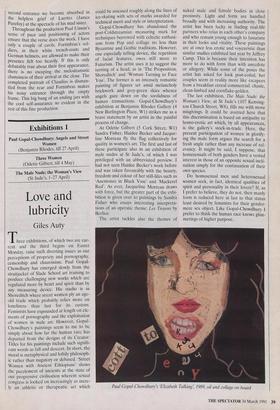Exhibitions 1
Paul Gopal-Chowdhury: Angels and Street Women (Benjamin Rhodes, till 27 April) Three Women (Odette Gilbert, till 4 May)
Love and lubricity
Giles Auty
hrce exhibitions, of which two are cur- rent and the third begins on Easter Monday, raise such diverting issues as our perceptions of propriety and pornography, censorship and chauvinism. Paul Gopal- Chowdhury has emerged slowly from the straitjacket of Slade School art training to produce challenging new works which are regulated more by heart and spirit than by any measuring device. His studio is in Shoreditch where street women ply an age- old trade which probably relies more on loneliness than lust for its custom. Feminists have expounded at length on ele- ments of pornography and the exploitation of women in male art. However, Gopal- Chowdhury's paintings seem to me to be simply about how far the human race has departed from the designs of its Creator. Titles for his paintings include such signifi- cant words as fall and descent. In short, the mood is metaphysical and loftily philosoph- ic rather than nugatory or debased. 'Street Women with Ancient Ethiopians' shows the puzzlement of ancients at the state of our progressive civilisation wherein sexual congress is looked on increasingly as mere- ly an athletic or therapeutic act which could be assessed roughly along the lines of ice-skating with sets of marks awarded for technical merit and style or interpretation.
Gopal-Chowdhury has abandoned the post-Coldstreamian measuring mark for techniques borrowed with eclectic enthusi- asm from Pop and collage no less than Byzantine and Gothic traditions. However, one especially telling device, the repetition of facial features, owes still more to Futurism. The artist uses it to suggest the turning of a head, as in 'The Proposition, Shoreditch' and 'Woman Turning to Face You'. The former is an intensely romantic painting of figures set amid melancholy brickwork and grey-green skies whence angels gaze down on the sordidness of human transactions. Gopal-Chowdhury's exhibition at Benjamin Rhodes Gallery (4 New Burlington Place, W1) strikes me as a brave statement by an artist in the painful process of change.
At Odette Gilbert (5 Cork Street, WI) Sandra Fisher, Haidee Becker and Jacque- line Morreau fly the flag collectively for quality in women's art. The first and last of these participate also in an exhibition of male nudes at St Jude's, of which I was privileged with an abbreviated preview. I had not seen Haidee Becker's work before and was taken favourably with the beauty, freedom and colour of her still-lifes such as 'Anemones in Black Vase' and 'Mackerel Red'. As ever, Jacqueline Morreau draws with force, but the greater part of the exhi- bition is given over to paintings by Sandra Fisher who essays interesting interpreta- tions of an operatic theme: Les Troyens by Berlioz.
The artist tackles also the themes of naked male and female bodies in close proximity. Light and form are handled broadly and with increasing authority. The artist has been lucky in finding real-life partners who relax in each other's company and who remain young enough to luxuriate in their looks and vitality. These paintings are at once less erotic and voyeuristic than similar studies exhibited last year by Jeffrey Camp. This is because their intention has more to do with form than with anecdote or allegory. While some of the poses the artist has asked for look post-coital, her couples seem in reality more like escapees from a breakfast cereal commercial: chaste, clean-limbed and cornflake-golden.
The last exhibition, The Male Nude.• the Woman's View, at St Jude's (107 Kensing- ton Church Street, W8), fills me with more misgivings. It could be averred here that this discrimination is based on antipathy to homo-erotic art which, by all appearances, is the gallery's stock-in-trade. Here, the present participation of women in glorify- ing the male form argues the search for a fresh angle rather than any increase of rel- evancy. It might be said, I suppose, that homesexuals of both genders have a vested interest in those of an opposite sexual incli- nation simply for the continuation of their own species.
Do homosexual men and heterosexual women seek, in fact, identical qualities of spirit and personality in their lovers? If, as I prefer to believe, they do not, then manly form is reduced here at last to that status least desired by feminists for their gender: mere sex object. Like Gopal-Chowdhury I prefer to think the human race knows glim- merings of higher purpose.
Paul Gopal-Chowdhwy's 'Elizabeth Talking, 1989, oil and collage on hoard


















































 Previous page
Previous page